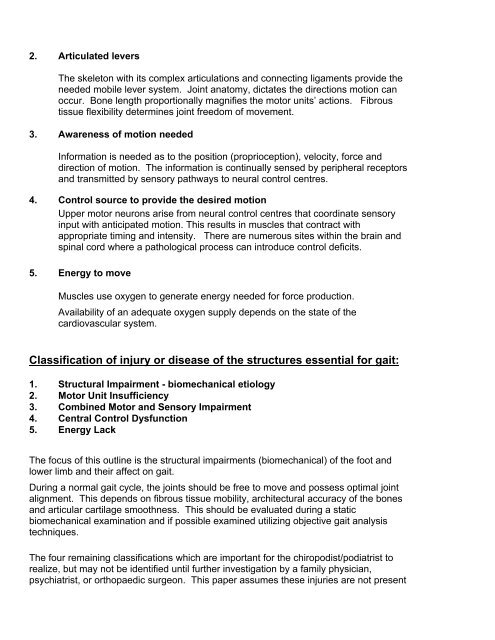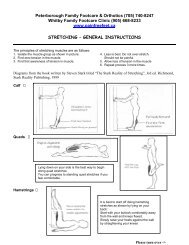Gait Analysis Handout - painfreefeet.ca
Gait Analysis Handout - painfreefeet.ca
Gait Analysis Handout - painfreefeet.ca
Create successful ePaper yourself
Turn your PDF publications into a flip-book with our unique Google optimized e-Paper software.
2. Articulated levers<br />
The skeleton with its complex articulations and connecting ligaments provide the<br />
needed mobile lever system. Joint anatomy, dictates the directions motion <strong>ca</strong>n<br />
occur. Bone length proportionally magnifies the motor units’ actions. Fibrous<br />
tissue flexibility determines joint freedom of movement.<br />
3. Awareness of motion needed<br />
Information is needed as to the position (proprioception), velocity, force and<br />
direction of motion. The information is continually sensed by peripheral receptors<br />
and transmitted by sensory pathways to neural control centres.<br />
4. Control source to provide the desired motion<br />
Upper motor neurons arise from neural control centres that coordinate sensory<br />
input with anticipated motion. This results in muscles that contract with<br />
appropriate timing and intensity. There are numerous sites within the brain and<br />
spinal cord where a pathologi<strong>ca</strong>l process <strong>ca</strong>n introduce control deficits.<br />
5. Energy to move<br />
Muscles use oxygen to generate energy needed for force production.<br />
Availability of an adequate oxygen supply depends on the state of the<br />
<strong>ca</strong>rdiovascular system.<br />
Classifi<strong>ca</strong>tion of injury or disease of the structures essential for gait:<br />
1. Structural Impairment - biomechani<strong>ca</strong>l etiology<br />
2. Motor Unit Insufficiency<br />
3. Combined Motor and Sensory Impairment<br />
4. Central Control Dysfunction<br />
5. Energy Lack<br />
The focus of this outline is the structural impairments (biomechani<strong>ca</strong>l) of the foot and<br />
lower limb and their affect on gait.<br />
During a normal gait cycle, the joints should be free to move and possess optimal joint<br />
alignment. This depends on fibrous tissue mobility, architectural accuracy of the bones<br />
and articular <strong>ca</strong>rtilage smoothness. This should be evaluated during a static<br />
biomechani<strong>ca</strong>l examination and if possible examined utilizing objective gait analysis<br />
techniques.<br />
The four remaining classifi<strong>ca</strong>tions which are important for the chiropodist/podiatrist to<br />
realize, but may not be identified until further investigation by a family physician,<br />
psychiatrist, or orthopaedic surgeon. This paper assumes these injuries are not present



